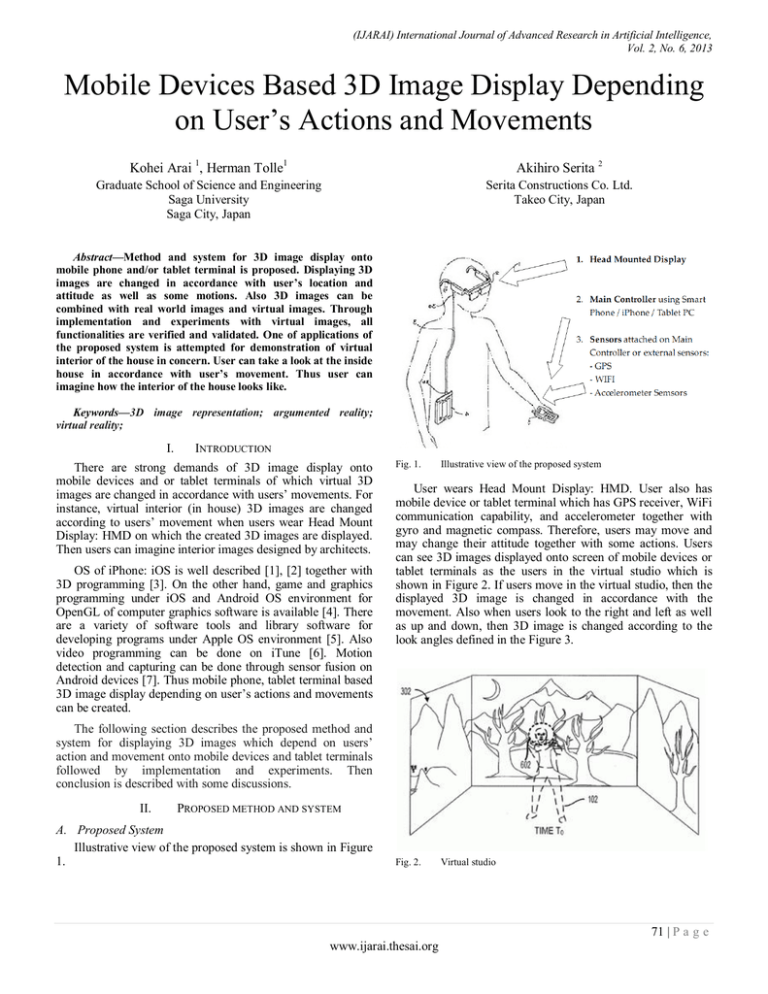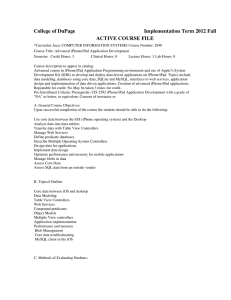Mobile Devices Based 3D Image Display Depending on User`s
advertisement

(IJARAI) International Journal of Advanced Research in Artificial Intelligence, Vol. 2, No. 6, 2013 Mobile Devices Based 3D Image Display Depending on User’s Actions and Movements Kohei Arai 1, Herman Tolle1 Akihiro Serita 2 Graduate School of Science and Engineering Saga University Saga City, Japan Serita Constructions Co. Ltd. Takeo City, Japan Abstract—Method and system for 3D image display onto mobile phone and/or tablet terminal is proposed. Displaying 3D images are changed in accordance with user’s location and attitude as well as some motions. Also 3D images can be combined with real world images and virtual images. Through implementation and experiments with virtual images, all functionalities are verified and validated. One of applications of the proposed system is attempted for demonstration of virtual interior of the house in concern. User can take a look at the inside house in accordance with user’s movement. Thus user can imagine how the interior of the house looks like. Keywords—3D image representation; argumented reality; virtual reality; I. INTRODUCTION There are strong demands of 3D image display onto mobile devices and or tablet terminals of which virtual 3D images are changed in accordance with users’ movements. For instance, virtual interior (in house) 3D images are changed according to users’ movement when users wear Head Mount Display: HMD on which the created 3D images are displayed. Then users can imagine interior images designed by architects. OS of iPhone: iOS is well described [1], [2] together with 3D programming [3]. On the other hand, game and graphics programming under iOS and Android OS environment for OpenGL of computer graphics software is available [4]. There are a variety of software tools and library software for developing programs under Apple OS environment [5]. Also video programming can be done on iTune [6]. Motion detection and capturing can be done through sensor fusion on Android devices [7]. Thus mobile phone, tablet terminal based 3D image display depending on user’s actions and movements can be created. Fig. 1. Illustrative view of the proposed system User wears Head Mount Display: HMD. User also has mobile device or tablet terminal which has GPS receiver, WiFi communication capability, and accelerometer together with gyro and magnetic compass. Therefore, users may move and may change their attitude together with some actions. Users can see 3D images displayed onto screen of mobile devices or tablet terminals as the users in the virtual studio which is shown in Figure 2. If users move in the virtual studio, then the displayed 3D image is changed in accordance with the movement. Also when users look to the right and left as well as up and down, then 3D image is changed according to the look angles defined in the Figure 3. The following section describes the proposed method and system for displaying 3D images which depend on users’ action and movement onto mobile devices and tablet terminals followed by implementation and experiments. Then conclusion is described with some discussions. II. PROPOSED METHOD AND SYSTEM A. Proposed System Illustrative view of the proposed system is shown in Figure 1. Fig. 2. Virtual studio 71 | P a g e www.ijarai.thesai.org (IJARAI) International Journal of Advanced Research in Artificial Intelligence, Vol. 2, No. 6, 2013 III. METHOD USED A. Attitude Detection Accelerometer data, usually, too rapidly changed. Therefore, some low pass filter is needed for detect relatively smoothly changed attitude as shown in Figure 5. If the iPhone and iPad is inclined 90 degrees, then x and y axis is exchanged as shown in Figure 6. If users change their attitude in pitching direction as shown in Figure 8, then heading angle can be estimated with accelerometer data. Triple Axis Accelerometer (x, y, z) data can be transferred from iPhone to LIS302DL with communication through Low Level Accelerometer API: LLAAPI. These data should be filtered to remove shaking effect (using low pass filter). Fig. 3. Definition of user's location and looking angle B. System Architecture Proposed system architecture is shown in Figure 4. (a)Actual output signals (b)Filtered attitude signals Fig. 5. Acquired and processed attitude data (Red: x, Green: y and Blue: z directions, respectively) Fig. 4. Proposed system architecture Users’ action and movement can be detected with gesture recognition in the input controller which consists of accelerometer and gyro sensors. Recognize user movement as the input for controlling the view of 3D objects. Accelerometer sensors are using to detect user’s body move and front camera for detecting user’s head movement. Indoor and outdoor 3D images can be created in accordance with the users’ action and movements. These data are controlled by the main controller which includes front camera, GPS receiver, WiFi of equipments. Fig. 6. Horizontally situated iPhone and iPad Fig. 7. Pitching motions of users’ attitude changes Main controller has video output capability. Therefore, created 3D images can be displayed onto mobile phones and or tablet terminals together with HMD. Output Video is displayed into the screen of a HMD attached on user glasses. The view is changed base on the user’s movement. 72 | P a g e www.ijarai.thesai.org (IJARAI) International Journal of Advanced Research in Artificial Intelligence, Vol. 2, No. 6, 2013 Body turn around, head look to the left-right can be detected with direction sensors (azimuth). Also head look down-up can be detected with direction of gravity (altitude). Although direction of gravity did not tell the direction, direction can be determined by using Gyro Compass or GPS for outdoor case. For indoor case, we can use Compass (magneticHeading). Head movement (left-right) can be detected by using captured face image from rear camera, then using image processing for determine the movement. C. Control Camera Position, Orientation of 3D Space in Computer Graphics In order to create 3D Computer Graphics: CG images which depends on users’ action and movement by frame by frame basis, users’ position, action and face angle (head pose) has to be detected together with determination of camera position and looking angle, users’ orientation of line of sight, and relation between camera and 3D object. Figure 9 shows the process flow of controlling camera position, orientation of 3D space in Computer Graphics: CG. B. Detection of Walking The following three methods are attempted for detection of the linear movement: 1) Double integration of the acceleration to measure speed and then the distance. 2) Combination of Gyro Acceleration, Compass and Accelerometer to find Linear Movement 3) Using DeviceMotion Data (DeviceMotion is part of CoreMotion framework, a new framework on iOS as combination of Accelerometer & Gyr0) There are four types of motion on DeviceMotion: 1) UserAcceleration 2) Attitude 3) RotationRate 4) Gravity Each type of motion has different response for 3 different states (Stop, Walking, Rotating) Using the response of deviceMotion.rotationRate then we develop our new method for user walking detection. Walking can be detected by estimating cycle on accelerometer sensors signal. Figure 8 shows typical accelerometer output signals when users stay (Stable), move forward (Walking) and change their attitude in roll, pitch and yaw directions (Rotation). In the figure, left column shows the motion of users’ acceleration while right column shows the motion of users’ rotation rate (the first derivative). It is much easier to detect their motions by using rate data rather than the acceleration itself. Rotation can be detected by using the motion of users’ rotation rate in directions of roll, pitch and yaw angles. Rotation angles in direction of roll, pitch and yaw directions are estimated with the motion of users’ acceleration data. Meanwhile, walking can be detected by using the motion of users’ rotation rate. All of rotation rate in directions of roll, pitch and yaw directions is relatively small in comparison to that of the motion of users’ rotation. When users do not move, then accelerometer data shows stable while if users change their attitude in roll direction, then accelerometer shows relatively large changes in the corresponding direction. On the other hand, when users are walking, the accelerometer data shows small changes. Therefore, it is possible to detect users’ walk. Fig. 8. Typical accelerometer output signals (Motion of acceleration (left hand side and motion, rotation rate (right hand side) users’ Fig. 9. Process flow of controlling camera position, orientation of 3D space in computer graphics With the GPS receiver (Outdoor) and wireless LAN access point or WiFi access point (Indoor), users’ location can be estimated. Using acquired users gesture with front camera mounted on mobile devices and/or tablet terminal, camera orientation in 3D space of CG can be estimated. Also users’ head pose can be estimated by using the acquired image with the front camera. 73 | P a g e www.ijarai.thesai.org (IJARAI) International Journal of Advanced Research in Artificial Intelligence, Vol. 2, No. 6, 2013 IV. • • IMPLEMETATIONS A. Development Environment Development environment is shown below, • • • • • MacPro with OS X (Mountain Lion) Development Tools: Xcode 4.5.1 Programming Language: Objective-C Device: iPhone 4s / iPad2 / iPad Mini Registered as iOS Developer University Program (Saga University, max for 200 developers) • Scalar Head Mounted Display • iWear iPhone Video Glasses Development setup has to be done with the following procedure, • • Register as iOS Developer Register for iOS Developer University Program (free but limited for research purpose) • Register the device for Development and Testing • Get Certificate for the device and development permission • Start development using Xcode There are the following three modules for development, • 3D object Scene View Controlling Module • Loading, rendering, displaying, changes view based on user input (touch screen or from sensors), Collision detection • User Interface Controlling Module • Touch screen based controlling • Sensor based controlling • Walking, Turn Around, Look UpDown, Shake • Video Out System In the 3D object Scene View Controlling Module, there are the following features, TABLE I. OpenGL ES based Standard file format for 3D object: Wavefront format (.obj, .mtl) • Camera Frustum view based • Controlling the motion with touch screen: ▫ Rotate (Left | Right), ▫ Look (Up | Down), ▫ Step (Forward | Backward), ▫ Collision Detection (Front | Back) Body Movement recognizing module is based on the following methods, • Internal Sensors: Accelerometer, Gyro, Magnetometer • Pull Data access method • Update Interval (Frequency): 24 Hertz (24 data in one second) • Body movement method: ▫ Look Up – Look Down Altitude using Digital Compass ▫ Turn Around (Left – Right) Azimuth using Accelerometer ▫ Walking (Step Forward – Step Backward) Linear movement using MotionData.rotationRate ▫ Small Jump (Shake) Shake using Shake Event (Accelerometer) Users’ orientation can be estimated as follows, • • Pitch controlling using Digital Compass: magneticHeading vs true heading We use Core Location LocationManager: magneticHeading B. Device Selection Table 1 shows tradeoff table for possible devices for the proposed system. TRADEOFF TABLE FOR POSSIBLE DEVICES FOR THE PROPOSED SYSTEM. 74 | P a g e www.ijarai.thesai.org (IJARAI) International Journal of Advanced Research in Artificial Intelligence, Vol. 2, No. 6, 2013 Due to the fact that iPhone and iPad has a capability of gyro and magnetic compass and also has a capability to output 3D images to HMD easily, iPhone and iPad is used for the proposed system. Figure 10 shows the definition of coordinate system of the iPhone and iPad. Fig. 12. Outlook of the proposed system Figure 12 shows outlook of the proposed system. User wears the HMD which is attached to the iPhone in this case. In Figure 12, there is TV monitor for demonstration of the created 3D images by the iPhone. Fig. 10. Definition of coordinate system of iPhone and iPad.(Vertically situated case) C. Application Software Two application software, with and without walking detection are created. With walking detection of application software allows display 3D images in accordance with users’ action and movement, changing users’ head pose and users’ walking together with mobile devices orientations. Figure 13 shows the start display image onto mobile device. As is mentioned in the previous section, iPad is selected for the proposed system. The following HMD which is shown in Figure 11 can be attached to the iPad for displaying the created 3D images. Major specification of HMD is shown in Table 2. Fig. 13. Start home display image onto mobile device V. Fig. 11. Outlook of the HMD used TABLE II. MAJOR SPECIFICATION OF HMD USED Size Display_Size No.Pixels Viewing_Angle Video_Input Weight Power_Cosumption 154x21x40 60' 300x224 32° iPhone,iPod,iPad 80g 3.7V,160mA EXPERIEMNTS A. Examples of 3D Dispalyed Images When user looks to the right direction, displayed image is changed to the right image. That is the same thing for left, up, and down directions. Also when he or she walks forward, then displayed 3D image is changed to the front image. This is the same thing for backward direction. Figure 14 shows the displayed 3D image when user looks up and down, rotate in left and right directions, and step in forward and backward directions, respectively. 75 | P a g e www.ijarai.thesai.org (IJARAI) International Journal of Advanced Research in Artificial Intelligence, Vol. 2, No. 6, 2013 (a)Look up (d)Rotate right (e)Step forward (b)Look down (f)Step backward (c)Rotate left Fig. 14. Displayed 3D images when user look up and down, rotate in left and right directions, and step in forward and backward directions 76 | P a g e www.ijarai.thesai.org (IJARAI) International Journal of Advanced Research in Artificial Intelligence, Vol. 2, No. 6, 2013 In these cases, three axis coordinate and roll, pitch, and yaw rotation axis are defined as shown in Figure 15. (b)Rotation Fig. 17. Fig. 15. Definitions of three axis coordinate and roll, pitch, and yaw rotation axis Motion of rotation rate Figure 18 shows the acceleration and rotation rate when user walks. During walking, user acceleration in x, y, z directions is small. When user get close to the wall, 3D displayed image is close-up as shown in Figure 19. In accordance with users’ motion together with mobile phone movement, displayed 3D images are changed by frame by frame. Accelerometer data can be acquired 24 data a second. Taking every 6 data out of 24 data a second, users’ attitude, roll, pitch, and yaw angle is estimated. Therefore, 4 times a second of attitude data are used for updating the 3D images which have to be created. B. Example of 3D Display onto iPhone Figure 16 shows the example of 3D image display onto iPhone. Fig. 18. Fig. 16. Acceleration and rotation rate when user walks Example of 3D image display onto mobile phone C. Walking Detection Figure 17(a) shows the motion of rotation rate when user walks while Figure 17 (b) shows that when user rotating in roll direction. (a) (a)Walking 77 | P a g e www.ijarai.thesai.org (IJARAI) International Journal of Advanced Research in Artificial Intelligence, Vol. 2, No. 6, 2013 VI. COMCLUSION Method and system for 3D image display onto mobile phone and/or tablet terminal is proposed. Displaying 3D images are changed in accordance with user’s location and attitude as well as some motions. Also 3D images can be combined with real world images and virtual images. Through implementation and experiments with virtual images, all functionalities are verified and validated. One of applications of the proposed system is attempted for demonstration of virtual interior of the house in concern. User can take a look at the inside house in accordance with user’s movement. Thus user can imagine how the interior of the house looks like. ACKNOWLEDGMENT The authors would like to thank Arai’s laboratory members for their useful comments and suggestions during this research works. (b) Fig. 19. Example of 3D images during walking D. Augmented Reality Application One of Augmented Reality: AR applications are shown in Figure 20. The icon, description and character can be superimposed on real world images. Fig. 20. Application of the proposed system to AR [1] [2] [3] [4] [5] [6] [7] REFERENCES Alasdair Allan, Basic Sensors in iOS, O’Reilly, 2011 David Mark et al., Beginning iOS 6 Development exploring the iOS SDK, Apres, 2012 Philip Rideout, iPhone 3D Programming, O’Reilly, 2010 Romain Marucchi-Foino, Game and Graphics Programming for iOS and Android with OpenGL ES 2.0, John Wiley & Sons, Inc, 2012 Apple Developer Resource, http://developer.apple.com WWDC 2012 Session Videos, Developer on iTunes Sensor Fusion on Android Devices: A Revolution in Motion Processing, YouTube Video: http://www.youtube.com/watch?v=C7JQ7Rpwn2k AUTHORS PROFILE Kohei Aarai He received BS, MS and PhD degrees in 1972, 1974 and 1982, respectively. He was with The Institute for Industrial Science and Technology of the University of Tokyo from April 1974 to December 1978 and also was with National Space Development Agency of Japan from January, 1979 to March, 1990. During from 1985 to 1987, he was with Canada Centre for Remote Sensing as a Post Doctoral Fellow of National Science and Engineering Research Council of Canada. He moved to Saga University as a Professor in Department of Information Science on April 1990. He was a councilor for the Aeronautics and Space related to the Technology Committee of the Ministry of Science and Technology during from 1998 to 2000. He was a councilor of Saga University for 2002 and 2003. He also was an executive councilor for the Remote Sensing Society of Japan for 2003 to 2005. He is an Adjunct Professor of University of Arizona, USA since 1998. He also is Vice Chairman of the Commission-A of ICSU/COSPAR since 2008. He wrote 30 books and published 332 journal papers. 78 | P a g e www.ijarai.thesai.org



